Some further musical highlights from a little over two seasons, featuring the Warner gang at their peak – again rising to the level of hob-nobbing with Hollywood’s most elite. These weren’t the only “stars” in their eyes, however, as Bugs also gets to have his first interplanetary adventure, proving you can’t keep a good rabbit down – in this or any other galaxy.
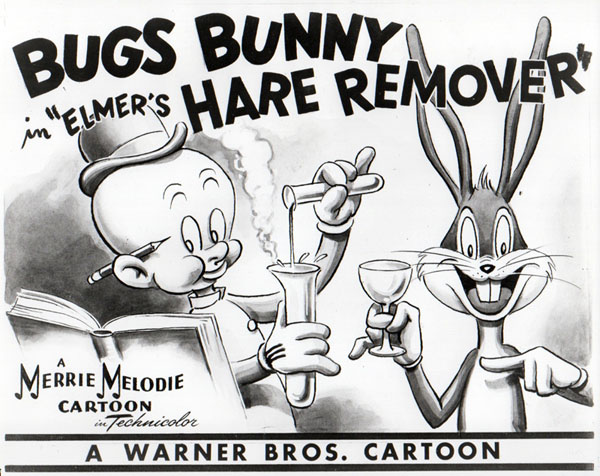
Hare Remover (3/23/46) – Elmer is trying to find a formula to convert a timid woodland creature into a “deviwish fiend”. He tries out his potion on a dog – which only turns the canine turn a vegetarian, eating grass to get rid of the awful taste. Experiments with Bugs seem more successful – only because of cases of mistaken identity, in which both Elmer and Bugs mistake a bear for each other after a dose of formula (“The stuff works!”). A “play dead” sequence with the bear mirrors the earlier Wabbit Twouble, while both Bugs and the bear take turns holding up illustrative signs depicting their opinions of their adversaries – “bats in the belfry”, a “cracked-pot”, a “screw’ and “ball”, and a “drip” from a faucet.
Songs: “Gotta Be This or That” is the new featured item, a “killer diller” swing number popularized and embellished by Benny Goodman, as something of a follow up to “Sing Sing Sing” (in performances, including a rare telecast on a prime time special, Swing into Spring in the 50’s, xylophonist Red Norvo would perform a featured solo with Benny, then rip the bars off his xylophione in mid- performance and toss them on the floor!). Benny himself also got to perform a vocal on this number – a rare luxury which did not often present itself in his normal repertoire. The song was issued as a deluxe two-part arrangement on Columbia, with both halves dubbed into one continuous performance for 12″ V-Disc. The song would have another well-placed use by Stalling in a later cartoon, the Academy Awatd nominated Walky Talky Hawky, accompanying Henery Hawk’s frustrations at trying to determine which “this” or “that” is really a chicken.

One Meat Brawl (1/18/47) – Grover Groundhog is anticipating his “big day” (Groundhog Day) – but finds his “public” to be predators and himself the prey thanks to a meat shortage. Porky and an early equivalent of Barnyard Dawg are the most active pursuers. Dawg, however, is of little help, as Grover finds his weakness (“Dogs are suckers for sob stories”). After several rounds of heart-wrenching tales leave the dog, and even Porky, bawling, the chase gravitates into a cave. A scene of violence and mayhem is portrayed in shadows on the wall, but a camera pan reveals it’s all an illusion, in the illumination of a flashlight. “Shadow boxing”, Porky observes. “That way, nobody gets hurt.” One original song is performed as a production number by Grover at the beginning of the picture – “A Groundhog and His Shadow”. Anyone know the composer? Stalling and Foster?
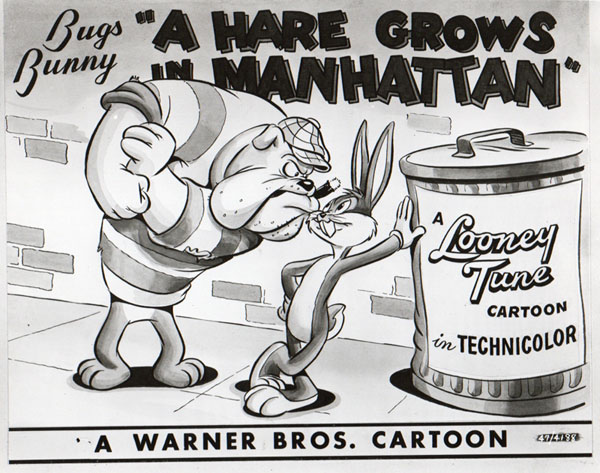
A Hare Grows In Manhattan (5/23/47) – Columnist Lola Beverly is doing interviews among the Hollywood movie colony, and devotes her attentions to its newest member – Bugs Bunny. Bugs tells of his youth in Manhattan, and especially of an altercation with a gang of tough dogs wearing turtle-meck sweaters. After various confrontations, the dogs corner Bugs in a blind alley. Bugs grabs a book from a bookstore shelf to use as a weapon – but one glance at it sends the dogs racing over the Brooklyn Bridge. The book’s title: “A Tree Grows in Brooklyn.”
Songs: “The Daughter of Rosie O’Grady”, recorded in 1918 for Columbia by “Robert Lewis” – a pseudonym for singer Lewis James (in an era when recording companies loved to use false names either to make their catalogue of singers appear larger than it really was, or to cover over names they thought sounded too ethnic). Henry Burr covered it for Pathe. An anonymous vocal appeared on Columbia’s 5 1/2″ “Little Wonder” series, sold for a dime. Nat Shilkret (as the “International Novelty Orchestra”) performed it as an “old timey” number for Victor in the late 1920’s. Revival versions into the late 78 period would include Gene Kelly on MGM (below), Eddie “Piano” Miller on Rainbow, and Joe “Fingers” Carr on Capitol. Also included in the score is a brief reference to an old hymn, “Revive Us Again”, recorded electrically by the Turney Brothers on Victor. Also, a return for “Hooray For Hollywood”.

A Pest in the House (8/3/47) – The labor shortage is getting critical, and employers will hire anybody – including Daffy Duck, as a hotel bellboy. His attempts to ensure that a tired customer’s demands for peace and quiet are met proves to be a cure worse than the disease. Elmer’s nose takes the brunt of the man’s reactions.
Songs: “Too-Ra-Loo-Ra-Loo-Ral (That’s an Irish Lullaby)”, most notably associates at the time and thereafter with Bing Crosby’s crooning rendition in the Paramount hit, “Going My Way”. Bing recorded a million selling version on Decca. Original recorded versions included acoustic performances by Chauncey Olcott for Columbia and George MacFarlane on Victor’s Purple and Blue Label Series. Versions more contemporary with the Crosby hit included Dennis Day on Victor, a band version by Charlie Spivak and his Orchestra also on Victor, Evelyn Knight for V-Disc, and Anne Shelton on British Decca. “Time Waits For No One” (below) also reappears, and the old nursery rhyme, “Pop Goes the Weasel”, becomes the recurring theme for the man’s repeated trips to the hotel lobby, the “Pop” being the sock in the kisser Elmer always receives.
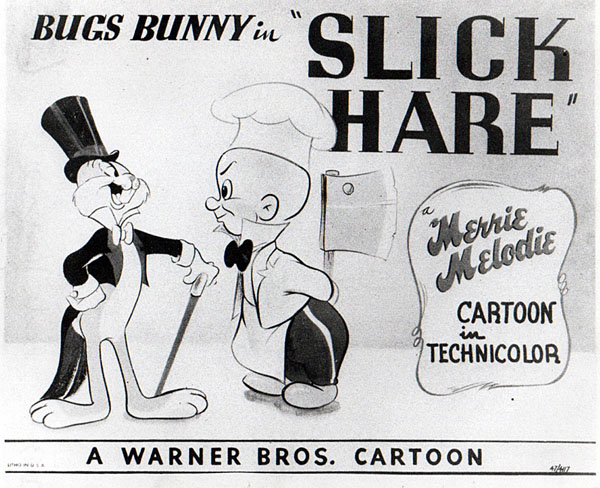
Slick Hare (11/1/47) – The stars are gathered at a fancy Hollywood restaurant, where Elmer is chief chef and waiter. Skinny Sinatra has trouble supping a drink through a large straw, and Ray Milland is paying the check with a cash register (set to haunting guitar music a la The Lost Weekend). Bogie (Humphrey Bogart) comes in, all bluster and threats – he wants fried rabbit and he wants it pronto – or else. Elmer believes he has none on hand – until he finds a stowaway in a crate of carrots. Bugs doesn’t want to exit fried, and a chase studded with movie star caricatures ensues. When it finally turns out that Bogie wants the rabbit for “Baby” (Lauren Bacall), Bugs is only happy to serve himself on a platter, and give out with wolf calls.
Musical highlight is a production number performed between Bugs Bunny and Carmen Miranda, featuring an original number co-composed for the production by Nestor Amaral (who had for a time worked with Miranda as part of the Bando Da Lua) entitled “Sambaiana”, of which no commercial recordings are known. The number is a tongue-in-cheek “tribute” song, as one blog’s translation of the lyric from Portuguese reveals that several of the titles of former Miranda hits are woven into the song’s narrative.
Other numbers include “But I Did” by Joseph Meyer, credited on sheet music as introduced by the Three Suns (though no commercial recording seems to exist), and also performed on records by Connee Boswell on Decca, and Dinah Shore on Victor (below) – this one is heard under the opening titles here and likewise on Kitty Kornered.
Also heard here is “All the Time”, a Sunny Skylar composition recorded by Lucky Millinder and his Orchestra for Decca; “Oh, But I Do”, by Arthur Schwartz, from the Warner picture, The Time, the Place, and the Girl, recorded by Margaret Whiting for Capitol, Harry James on Columbia, Tex Beneke on Victor (below), Bing Crosby for Decca, an Morton Downey on Majestic; “A Gal In Calico”, from the same picture, recorded by Benny Goodman on Columbia, Bing Crosby on Decca, Johnny Mercer on Capitol, Tony Martin on Mercury, Tex Beneke on Victor. Louis Prima on Majestic, Ahmad Jamal’s Three Strings on Okeh, and in England by Joe Loss for HMV; and returns for “About a Quarter to Nine”, “Nagasaki”, and “A Cup of Coffee, a Sandwich, and You”.
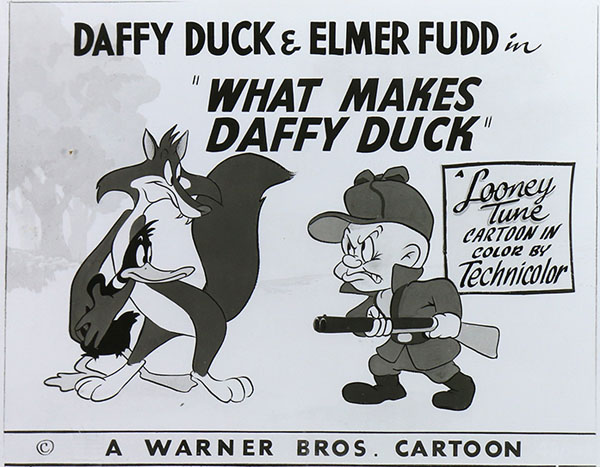
What Makes Daffy Duck? (2/14/48) – Typical screwy duck hunting cartoon, with an unusual twist. Daffy’s attentions are split between two rival competitors (Elmer, and an unnamed fox), both of which hunger for a duck dinner. One highlight features Elmer in drag as a sensuous duck decoy, with Daffy (who’s already wise to the disguise) completely blowing a famous cliche come-on line to lure the ladies – “I have some wonderful etchings up in my apartment – Wait here till I bring ‘em down.” Finally posing as a game warden, Daffy convinces the two pursuers that it’s now fox hunting season, sending them chasing after each other. “I am obviously dealing with inferior mentalities”, says Daffy.
Song: “King For a Day”, a pop tune from 1928, recorded for dancing by George Olsen on Victor and Ted Lewis on Columbia (below). Lou Gold recorded a late acoustical version on Harmony and Puritone. The Green Brothers Novelty Xylophone Band would record it for Okeh under the pseudonym “The Royal Music Makers”, their current moniker from a radio series sponsored by Royal Typewriters. Early vocal versions included Harry Richman on Brunswick, and Sam Coslow on Victor (who would later become well known as a song writer). Years later, Artie Shaw gave it a swing treatment on Victor, and Ted Fio Rito would give a similar approach on Decca. Joe Daniels and his Hot Shots in Drumnasticks would record a rhythm-heavy version for Parlophone. Richard Hayes revived it much later for Mercury.
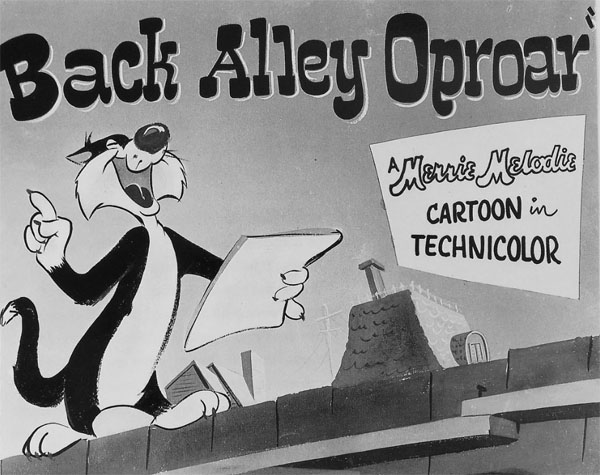
Back Allley Oproar (3/27/48) – Elmer Fudd is tired and wants to go to bed, but an alley cat (Sylvester) singing on the back fence keeps him awake all night. A remake of Notes To You (1941), with Elmer assuming the Porky Pig role. Songs: a repeat of the original “Largo al Factitum” intro gag from the Porky original, with the cat ducking vases between repetitions of “Figaro”; a theme from the Listz Second Hungarian Rhapsody, which Sylvester uses for a stair dance; “You Never Know Where You’re Going Till You Get There”, a Jule Styne and Sammy Kahn composition for the Warner Busby Berkeley production, Cinderella Jones (a film which, surprisingly, seems completely unavailable from any source, video or otherwise, and no commercial recordings of the song are known); “Carissima”; “Angel in Disguise” (delivered in the style of Spike Jones and his City Slickers), and, in repeat from the Porky original, the Sextet from Lucia Di Lammermoor, performed as a nonet by Sylvester’s nine lives.
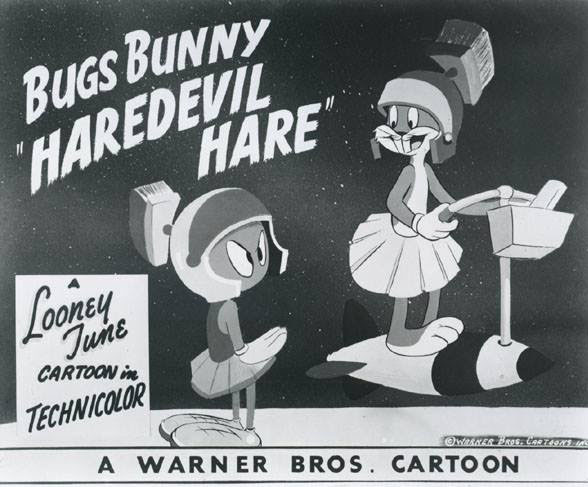
Haredevil Hare (7/24/48) – Bugs’ first brush with the Trojan helmet of Marvin Martian, and with the ever-gullible K-9. Bugs saves the Earth from the explosive power of the Aludium PU-36 explosive space modulator, but blows up the moon into a crescent in the process, leaving himself and the Martians hanging from its tip. The only original number is a variation on “Little Brown Jug” as an Earth commercial jungle for a breakfast cereal picked up on Bugs’ intercom, with the memorable lines, “Serve them to unwanted guests. Stuff the mattress with the rest.”
Next Time: The 1948-49 season – and some new melodies to carry the day.


 James Parten has overcome a congenital visual disability to be acknowledged as an expert on the early history of recorded sound. He has a Broadcasting Certificate (Radio Option) from Los Angeles Valley College, class of 1999. He has also been a fan of animated cartoons since childhood.
James Parten has overcome a congenital visual disability to be acknowledged as an expert on the early history of recorded sound. He has a Broadcasting Certificate (Radio Option) from Los Angeles Valley College, class of 1999. He has also been a fan of animated cartoons since childhood.











































Daffy’s rendition of “King for a Day” in “What Makes Daffy Duck” is one of my all time favorite Mel Blanc performances.
“A Gal In Calico” gets its best representation from Stalling as the title music for Davis’ “Catch as Cats Can” later in 1947.
“King for a Day” is a very poignant song (unless it’s being sung by Daffy in the shower). It comes from, the songwriting team of Lewis & Young, who also wrote “Laugh, Clown, Laugh”, a fairly literal paraphrase of the famous aria “Vesti la giubba” from the opera I Pagliacci. So I wonder if there might be another operatic allusion here.
“King for a Day” (Un giorno di regno) was Giuseppe Verdi’s second opera, his first comedy, and his first failure. It’s very obscure and seldom staged, but the one thing opera lovers know about it is that Verdi’s wife and two children all died while he was composing it. He was devastated, and would not attempt comedy again until his very last opera, Falstaff, over fifty years later.
I can’t help but think of Verdi’s personal tragedy while listening to “King for a Day”. Even though he became very successful and wealthy, and ultimately remarried (but had no more children), he could never “be that happy one,” smiling at the sun. But “the heart that can sing is greater and richer than princes or kings” — that’s a lovely motto.
“Ray Milland is paying the check with a cash register”– I think you mean typewriter (and gets change in little typewriters, as I recall) since in “The Lost Weekend” he tries to pawn his type writer to buy booze.
One of the interesting discoveries I found when perusing LT cue sheets was “Make it Snappy” by Floyd J. St. Clair, which plays in A Pest in the House (during the mad dash to the basement), as well as repeatedly in Rabbit Transit (telegram: “GO!”) and The Grey-Hounded Hare (“What? Dogs chasing that cute little bunny?”).
Unfortunately I’ve been unable to find a recording of it.
Also featured in Hare Remover: “The Wish That I Wish Tonight” sung by Dennis Morgan in 1945’s Christmas in Connecticut.
“What Makes Daffy Duck” in “Color by Technicolor” – when it was a Cinecolor short?? Anyhow, thanks.
BTW, Stan Freberg’s the groundhog from “One Meat Brawl” & Dave Barry plays Bogey in “Slick Hare”.
“Time Waits For No One” is also main titles music for 1947’s “Crowing Pains”.
Among the cartoons you skipped over:
A personal favorite, “A Hick, A Slick, and a Chick:”(one shot with psuedo-Sylvester, Art Davis)(MM, 3/18/1948)..has Elmo the Hick mouse (no establishing shot, though), going to the big city to woo his girlfriend,m Daisy Lou (not to be confused with “Daisy Lou” from Hare Splitter, mentioned in the next Parten review), only she’s now being courted by “Blackie”, a slicker, girlfriend-stealing villian… complete with handlebar-thin-mustache. (A moustache?) Stan Freberg as Elmo sings a vocal take on The Hoosier Hot Shots’s “Rural Rhythm”, at the beginning, reprised when our hero gets drunk to get the “ermine” he’s been challenged with, by Mel Blanc (handling the drunk voice, with Emery Hawkins handling the animation). “In and Out the Window” when he hunts around before getting drunk, a rare item, also on a later Season 1 “Gilligan”, “How not to be a Hero”, is heard, as is (at the end) a song used in “Tweety Pie”,”Lovelorn Leghorn”,”Wise Quacking Duck”, and some others, “Why Don’t You Fall in Love with Me” (Wrubel-Jones), as the cat featured, now with (Freberg as Jimmy Durante, walks off. “Arkansas Traveleer’ is heard when “Elmo” gets punched by “Blackie'(something many might wish on a certain “Muppet”) into the street, alongside the typical trains, buses, streetcars,and trolleys, going back only to get socked back out by Blackie.
In “Bugs Bunny Rides Again”, with the title character and Yosemtie Sam (Merrie Melodies, 5/22/1948), directed by Friz Freleng, Sam and Bugs are in theuir usual standard Western where Carl Stalling brings out thesame dance he used in “1944’s “Stage Door Cartoon” and 1948’s “Hare Splitter”.
And there’s those usages in McKimson’s “Upstanding Sitter”(Looney Tunes, Daffy, pseudo-Henery), of “She Was an Acrobat’s Daughter” (Ruby-Kalmar), “Umbrella Man”(Rose), and “Powerhouse”(Scott). And Daffy’s own “singing”/speaking his praises “Life is better, for I’m a sitter…”, in the original near-opening rhyme. And at the beginning, the classic Egbert Van Alstyne and Gus Kahn hit, “Pretty Baby”, over the titles.
“A Pest in the House”, I’d like to call it a smash hit. What’s more, in addition to voicing Elmer Fudd, Arthur Q. Bryan uses his natural voice to portray the tall, stout tired man.